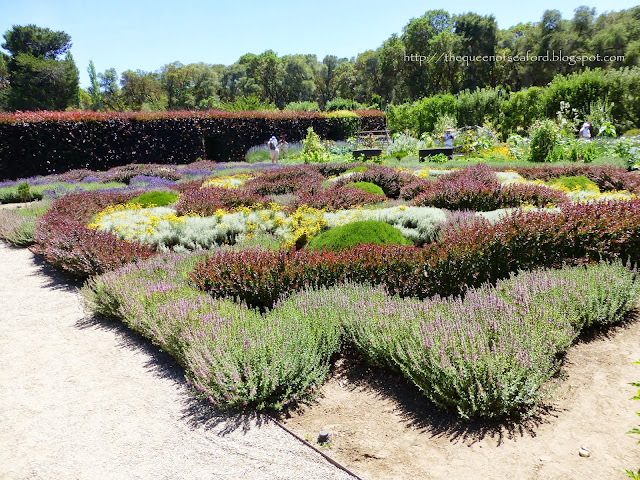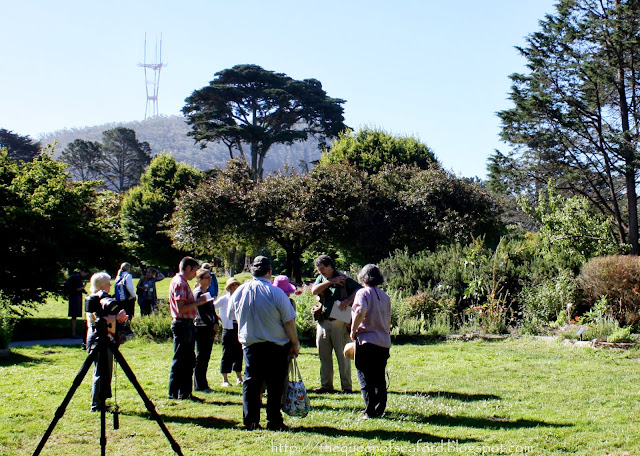Let me start with one of my favorite finds from my woods. This is Crane-fly Orchid or Tipularia discolor, a lovely little native that has foliage in the winter which disappears during the summer. I have posted its leaves before- here and here and the blooms here. The challenge is to remember where the leaves were during the winter. I put sticks in the ground, surrounding the area. After three years, I probably don't need the sticks anymore, I KNOW where these babies are! Photographing the slender stalks with their blooms is not easy. I had just come back from the mailbox when I first saw this year's blooms, so I used the back of an envelope to give a plain backdrop.
The exciting part of this year's flower stalks was that there were three stalks. Seems my little plot of Tipularia discolor is growing!
Not happy with the white background I came in and got the black apron to give a dark backdrop. Ignore the dog hair.
This time of year there are all sorts of blooms opening in the woods and it is always a surprise to find where some pop up. The Spurred Butterfly Pea or Centrosema virginianum is a large purple bloom. It grows on a vine that shows up in various spots through the woods. I have posted about this beauty about four times. Here, here, here and here. Isn't she a beauty? It was a new plant to me when I first moved here, now I feel like she is an old friend. Her delicate vine twists through various shrubs in the woods or across the open ground, she isn't picky.
See how large the bloom is? It is big enough to make you stop and look to see what that pretty purple bloom might be.
I am including her in this Wildflower Wednesday posting because I have collected a few seed pods. I took an old aluminum pan outside to put under the pod as I clipped it from the vine. Good thing I did that as it acted like a spring that needed to coil. The very dry, ripe pods will pop into a spiral fashion, dispersing the seeds outward. Mother Nature is pretty clever in her ways of spreading seeds.
These are long narrow pods.....they are dark brown when they are ripe and almost disappear against the forest.
They are native all across the South, as far west as Texas and as far north as New Jersey. You can see the range here....so--- I have enough seeds to share with three of you (maybe more if I can find more seed pods). If you are interested in trying your hand in growing this pretty little vine....tell me in the comments. If there are more than three I will pick three names.
And now for our mystery vine. It blooms late -- fully in bloom photos are from October last year, the stem is squared, the leaves are heart-shaped, arranged opposite each other, with new growth also springing from the nodes. I have looked for this on Namethatplant.net and have had no luck.
Here it is again this summer, buds plump and soon to open. I have looked for it in all my wildflower books, to no avail.
The squared stems seem to be reddish purple this year. Maybe they age to a green color by October. They grow along my shoreline of the lake.
In the fall there are lots of little bees enjoying the blooms.
Interesting intersection of stems and leaves.
Here is the squared stem. Any ideas?
It is interspersed with Apios americana, Groundnut, which was the subject of another post a few years ago. When I first saw the vine last year I thought it might be the Groundnut, but no--- something new!
If you have any ideas please let me know. Sure would like to identify this one. Be sure to stop over to Gail's blog- clayandlimestone.com to see her Wildflowers and others' who have contributed.
Tina mentioned she needed a better photo of the leaves--- so here is one more photo of our mystery vine. Well our mystery vine has been IDed! Gail found it. It is Mikania scandens, Climbing Hempweed!
©Copyright 2013 Janet. All rights reserved. Content created by Janet for The Queen of Seaford.














































































